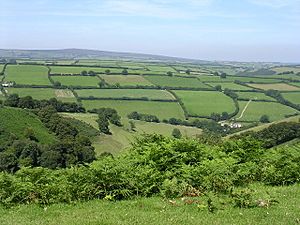South Exmoor SSSI facts for kids
| Site of Special Scientific Interest | |
 |
|
| Area of Search | Somerset & Devon |
|---|---|
| Coordinates | 51°05′40″N 3°36′03″W / 51.09434°N 3.60075°W |
| Interest | Biological |
| Area | 3,132.7 hectares (31.327 km2; 12.095 sq mi) |
| Notification | 1992 |
South Exmoor is a very special natural area in England. It covers a huge space across parts of Devon and Somerset. This area is so important for nature that it's called a Site of Special Scientific Interest, or SSSI. It was given this special protection in 1992.
Contents
Discovering South Exmoor's Nature
South Exmoor is a large area, about 3,132 hectares (that's like 7,742 football fields!). It's a "biological" SSSI. This means it's protected because of its amazing plants and animals.
What Makes South Exmoor Special?
A Site of Special Scientific Interest (SSSI) is a place in the UK that has important wildlife or geology. These sites are protected by law. This helps to keep their special features safe for the future. South Exmoor is one of these important places.
Where is South Exmoor Located?
South Exmoor is made up of several pieces of land. These pieces are all found on the southern side of Exmoor. Some parts are in Devon, and others are in Somerset.
- In Devon: You'll find areas like Barcombe Down and North Molton Ridge. These are southeast of South Radworthy. There's also Molland Common, which is north of Molland. And don't forget West Ansty and East Ansty Commons.
- In Somerset: Parts include Brightworthy Barrows and a section of Withypool Common. Winsford Hill and Haddon Hill are also part of it. All these Somerset areas are inside the Exmoor National Park.
Amazing Habitats of South Exmoor
South Exmoor has different types of natural homes for plants and animals. These include wide-open heathlands, flowing rivers, and quiet woodlands.
Heathlands: A Special Landscape
A big part of South Exmoor is covered in heathland. These are open areas with low-growing plants like heather. Some of these heathlands are "lowland communities." This means they are found in lower areas. These specific types of heathland are quite rare. You can only find them in South West England and South Wales.
Rivers and Water Plants
The River Barle flows through parts of South Exmoor. Many smaller streams also join it. These rivers are home to special water plants. One common plant is called alternate watermilfoil. It grows under the water and is very important for river life.
Ancient Woodlands
There are also small areas of natural woodland within South Exmoor. Some of these woods are very old, known as ancient woodlands. The most common tree you'll see is the sessile oak. The ground under the trees often has plants like bracken and bilberry. You can also find many different types of mosses growing there.
Wildlife of South Exmoor
South Exmoor is a fantastic place for birds and other animals. The different habitats provide homes for many species.
Birds of the Heathland
The heathlands are perfect for certain birds. You can often spot whinchat and stonechat here. They love to breed in these open, shrubby areas.
Birds of Stony Places
If you look near stone walls or rocky spots, you might see wheatear. These birds are common in stony areas.
Birds of Scrub and Tall Plants
The grasshopper warbler likes to live in areas with thick bushes or tall heath. They are known for their unique, insect-like song.
Birds of the Moorland Edges
The trees at the edge of the moorland provide safe places for birds to build nests. You might find nests of redpoll, buzzard, and raven here. Buzzards are large birds of prey, and ravens are big, clever birds.

